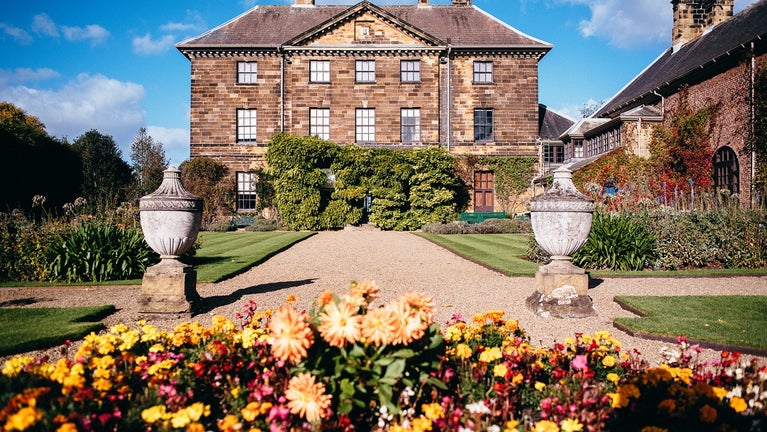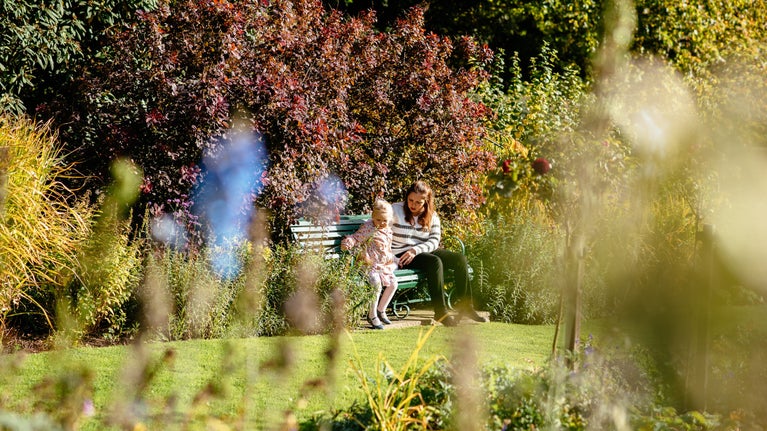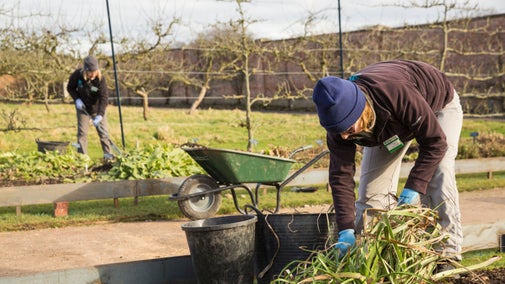
Discover more at Ormesby Hall
Find out when Ormesby Hall is open, how to get here, the things to see and do and more.

Explore the garden at Ormesby Hall, to discover a green oasis in the heart of industrial Middlesbrough. Enjoy the seasonal delights of this colourful Victorian formal garden and embrace the family fun on the woodland walk and natural play area.
The garden at Ormesby is still full of colour throughout autumn. Amaranthus, Dahlias, Calendula and the annual seed mixes in the borders provide late season colour right up to the first frosts. The Copper Beech shows off its wonderful mix of leaf shades as it changes colour through the season in anticipation of dropping its leaves in November.
The deep red of the smoke bush (Cotinus) stands out among the changing autumn colours, the bench under the smoke bush is the perfect place to sit and enjoy the changing season.
Autumn is a great time to explore the woods at Ormesby, bright red berries on the hawthorn and holly trees, acorns appear on the oaks and shining conkers are appearing from their spiky cases on the chestnut trees, and lots of interesting fungi can be found around the gardens and woodland.
The wonderful Jay is elusive for much of the year however in autumn, when it is collecting and hiding its stash of acorns, it becomes more conspicuous. We are lucky at Ormesby that we can get some splendid views of them around the garden and grounds.
Autumn is also an important time to remind people of the plight of our hedgehogs. It is important for people to feed hedgehogs at this time of year to get them up to the correct weight for hibernation or they will not make it through the winter. Also, it is the perfect time to build a hedgehog box (some great simple/cheap options online) to put in your garden at home. Hogs need to find the boxes and check them out in autumn, so they know where to go to hibernate when the winter weather arrives. Feeding birds is also an important autumn job, as they need that extra food in autumn to gain energy reserves ready for winter.
Autumn is an exciting time to explore the woods at Ormesby. Fungi found at this time of year around Ormesby can include Artists Fungus (Ganoderma Applanatum), Giant Polypore (Meripilus Giganteus), Turkey Tail (Trametes Versicolor), Scarlet Elfcup (Saroscypha Austriaca) and Dryad’s Saddle (Cerioporus Squamosus). Fungi play a vital role within our ecosystems, helping to recycle nutrients from dead or decaying organic matter, aiding trees, and plants in the capture of water and nutrients and providing food and shelter for a variety of wildlife.
Ivy is also a really important plant, not only providing late season flowers for the insects to forage, which is essential feeding before the winter months. Providing berries for birds and then providing warm roosting sites for insects, mammals and birds through the colder months. Have a look at the ivy in autumn, it will be buzzing with small insects, hoverflies and micromoths.

At Ormesby Hall we are gardening with nature in mind, the wildflower meadows are increasing their diversity year on year. The meadow adds beautiful colour and creates a relaxing space, attracting insects like bees, hoverflies, butterflies and moths.
Keep an eye out for Nuthatches and Treecreepers which you can often be seen on our mature trees around the garden and estate.
The meadow orchard is a great place to spend some time enjoying nature in the calm tranquil and atmosphere of this newly established part of the gardens.
The pond will be alive with native pond plants and a host of water loving creatures such as pond skaters on the water and dragonflies flying above.
Visitors can help by keeping dogs under close control as they can cause issues for a variety of wildlife and farm animals.
The Ormesby estate has 240 acres of woodlands, crop fields, running streams and open fields to explore, so stretch your legs, get the little ones out in nature, walk your four-legged friends and enjoy the parkland.
There are three waymarked walks across the estate, each 1.2–1.5 miles in length and taking in woodlands, St Cuthbert’s Church, local farms and a mini waterfall. Speak to the team on arrival for information on where to start the walks.
Many of the walks take you past our tenant farmer’s fields, where you may see sheep with the spring lambs and horses grazing. Please follow the countryside code whilst walking on the estate.

Find out when Ormesby Hall is open, how to get here, the things to see and do and more.
Discover more about the ‘creating a space for nature’ project at Ormesby Hall which aims to create a green oasis and nature-rich haven in the heart of urban Middlesbrough.
Ormesby Hall is a two pawprint rated place. Dogs are welcome throughout the gardens, woodland walks and parkland. With acres to explore it’s a great place to share with your dog.

From 18th-century water gardens and Arts and Crafts landscapes to intimate woodland gardens, there are so many places to discover.

Discover our gardeners’ top tips so you can make the most of your garden, plot or window box.

From ornamental magnolias in gardens to blackthorn scattered across the countryside, discover some of the best places to see blossom in our care.
